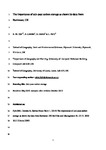The importance of sub‐peat carbon storage as shown by data from <scp>D</scp>artmoor, <scp>UK</scp>
| dc.contributor.author | Fyfe, R | |
| dc.contributor.author | Coombe, R | |
| dc.contributor.author | Davies, H | |
| dc.contributor.author | Parry, L | |
| dc.date.accessioned | 2017-01-05T15:46:50Z | |
| dc.date.available | 2017-01-05T15:46:50Z | |
| dc.date.issued | 2014-03 | |
| dc.identifier.issn | 0266-0032 | |
| dc.identifier.issn | 1475-2743 | |
| dc.identifier.uri | http://hdl.handle.net/10026.1/8203 | |
| dc.description.abstract |
<jats:title>Abstract</jats:title><jats:p>Peatlands are highly valued for their range of ecosystem services, including distinctive biodiversity, agricultural uses, recreational amenities, water provision, river flow regulation and their capacity to store carbon. There have been a range of estimates of carbon stored in peatlands in the <jats:styled-content style="fixed-case">U</jats:styled-content>nited <jats:styled-content style="fixed-case">K</jats:styled-content>ingdom, but uncertainties remain, in particular with regard to depth and bulk density of peat. In addition, very few studies consider the full profile with depth in carbon auditing. The importance of sub‐peat soils within peatland carbon stores has been recognized, but remains poorly understood and is included rarely within peatland carbon audits. This study examines the importance of the carbon store based on a study of blanket peat on <jats:styled-content style="fixed-case">D</jats:styled-content>artmoor, <jats:styled-content style="fixed-case">UK</jats:styled-content>, by estimating peat depths in a 4 × 1 km survey area using ground penetrating radar (<jats:styled-content style="fixed-case">GPR</jats:styled-content>), extraction of 43 cores across a range of peat depth, and estimation of carbon densities based on measures of loss‐on‐ignition and bulk density. Comparison of <jats:styled-content style="fixed-case">GPR</jats:styled-content> estimates of peat depth with core depths shows excellent agreement, to provide the basis for a detailed understanding of the distribution of peat depths within the survey area. Carbon densities of the sub‐peat soils are on average 78 and 53 kg C/m<jats:sup>3</jats:sup> for the overlying blanket peat. There is considerable spatial variability in the estimates of total carbon from each core across the survey area, with values ranging between 56.5 kg C/m<jats:sup>2</jats:sup> (1.01 m total depth of peat and soil) and 524 kg C/m<jats:sup>2</jats:sup> (6.63 m total depth). Sub‐peat soil carbon represents between 4 and 28 per cent (mean 13.5) of the total carbon stored, with greater values for shallower peat. The results indicate a significant and previously unaccounted store of carbon within blanket peat regions which should be included in future calculations of overall carbon storage. It is argued that this store needs to be considered in carbon audits.</jats:p> | |
| dc.format.extent | 23-31 | |
| dc.language | en | |
| dc.language.iso | en | |
| dc.publisher | Wiley | |
| dc.subject | peat depth | |
| dc.subject | soil carbon | |
| dc.subject | Peatlands | |
| dc.subject | Dartmoor | |
| dc.subject | ground penetrating radar | |
| dc.subject | carbon storage | |
| dc.title | The importance of sub‐peat carbon storage as shown by data from <scp>D</scp>artmoor, <scp>UK</scp> | |
| dc.type | journal-article | |
| dc.type | Journal Article | |
| plymouth.author-url | https://www.webofscience.com/api/gateway?GWVersion=2&SrcApp=PARTNER_APP&SrcAuth=LinksAMR&KeyUT=WOS:000332773900004&DestLinkType=FullRecord&DestApp=ALL_WOS&UsrCustomerID=11bb513d99f797142bcfeffcc58ea008 | |
| plymouth.issue | 1 | |
| plymouth.volume | 30 | |
| plymouth.publication-status | Published | |
| plymouth.journal | Soil Use and Management | |
| dc.identifier.doi | 10.1111/sum.12091 | |
| plymouth.organisational-group | /Plymouth | |
| plymouth.organisational-group | /Plymouth/Admin Group - REF | |
| plymouth.organisational-group | /Plymouth/Admin Group - REF/REF Admin Group - FoSE | |
| plymouth.organisational-group | /Plymouth/Faculty of Science and Engineering | |
| plymouth.organisational-group | /Plymouth/Faculty of Science and Engineering/School of Geography, Earth and Environmental Sciences | |
| plymouth.organisational-group | /Plymouth/REF 2021 Researchers by UoA | |
| plymouth.organisational-group | /Plymouth/REF 2021 Researchers by UoA/UoA14 Geography and Environmental Studies | |
| plymouth.organisational-group | /Plymouth/Research Groups | |
| plymouth.organisational-group | /Plymouth/Research Groups/Marine Institute | |
| plymouth.organisational-group | /Plymouth/Users by role | |
| plymouth.organisational-group | /Plymouth/Users by role/Academics | |
| dc.rights.embargodate | 2015-03-01 | |
| dc.identifier.eissn | 1475-2743 | |
| dc.rights.embargoperiod | 12 months | |
| rioxxterms.versionofrecord | 10.1111/sum.12091 | |
| rioxxterms.licenseref.uri | http://www.rioxx.net/licenses/under-embargo-all-rights-reserved | |
| rioxxterms.type | Journal Article/Review |


